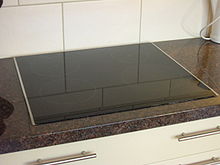Our website is made possible by displaying online advertisements to our visitors.
Please consider supporting us by disabling your ad blocker.
Induction cooking

Induction cooking is a cooking process using direct electrical induction heating of cooking vessels, rather than relying on indirect radiation, convection, or thermal conduction. Induction cooking allows high power and very rapid increases in temperature to be achieved: changes in heat settings are instantaneous.[1]
Cooking vessels with suitable bases are placed on an induction electric stove (also "induction hob" or "induction cooktop") which generally has a heat-proof glass-ceramic surface above a coil of copper wire with a low radio frequency alternating electric current passing through it. The resulting oscillating magnetic field induces an electrical current in the vessel. This large eddy current flowing through the resistance of a thin layer of metal in the base of the vessel results in resistive heating.
For nearly all models of induction cooktops, a cooking vessel must be made of, or contain, a ferrous metal such as cast iron or some stainless steels. The iron in the pot concentrates the current to produce heat in the metal. If the metal is too thin, or does not provide enough resistance to current flow, heating will not be effective. Induction tops typically will not heat copper or aluminum vessels because the magnetic field cannot produce a concentrated current, but cast iron, carbon steel and stainless steel pans usually work. Any vessel can be used if placed on a suitable metal disk which functions as a conventional hotplate.
Induction cooking has good coupling between the pan and the coil and is thus quite efficient, which means it puts out less waste heat and it can be quickly turned on and off. Induction has safety advantages compared to gas stoves and outputs no air pollution into the kitchen. Cooktops are also usually easy to clean, because the cooktop itself has a smooth surface and does not get very hot.
Previous Page Next Page


